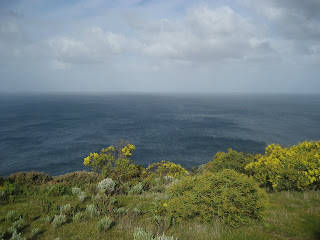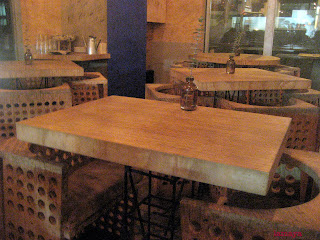photo from www.delange.org/Xochicalco_o/Xochicalco_o.htm
During our stay in Cuernavaca, Gretchen's and my relationship evolved from grammar and study to touristy/cultural events in and around the city.
A visit to Cuernavaca wouldn't be complete with out a visit to the pre-Colobian archaeological site of Xochicalco, located just 38 km southwest of town. The architecture of the site may have affinities with Teotihuacan, but the draw for me was the Solar Observatory.
The site was originally a natural cave which was modified to allow the study of the sun's movement between April 30 to August 15. During this time the sun shines into the cave and its movement can be tracked. Twice in its journey across the sky, when the sun is at its zenith (May 14/15 and July 28/29), an intense beam of light is cast onto the observatory floor.
Unfortunately, we would not be able to visit on the key dates, but still the site was a place I wanted to visit. I had convinced Gretchen that it would be a good day trip, but we were left with the question of how to get there. Like most places in Mexico, it was accessible by public transportation but this involved some planning. However, no matter how great the plans, there is always room for unexpected surprises.
Our trip to the archaeological site went off without a hitch. I am sure some people wouldn't be happy with the final 30 minute walk in the sun, but we couldn't be bothered waiting 40 minutes for a combi (a VW passenger bus) to take us to the gates. However, at the end of our visit to the site (which was nothing short of spectacular--even without the strong beam), we were thrilled to see the combi sitting at the gate. That enthusiasm dwindled as we approached a jammed packed van. The driver took one look at my 6 foot, blonde hair, blue-eyed companion and told those in the back to make room for me, as he so kindly climbed out of the driver's seat to make room for Gretchen between him and the other front seat passenger. From the look on the faces of my companions in the back I could tell they were far from happy trying to squeeze me in.
As we drove down the bumpy dirt road, the driver tried to chat up Gretchen. His feeble attempts were wasted, though I am not sure if it was because la Rubia was sick of always getting hit on or due to a lack of comprehension skills. Whatever the case, her body language showed relief when the passenger next to her yelled "baja" and soon exited the van. No sooner had the door closed and Gretchen moved closer to the door, when a large figure appeared on the horizon. The driver's scrowl turned to a grin and Gretchen's relief to tension as the near 300 pound figure hailed the combi. From my position I could not see how it would be physically possible for such a large person to squeeze into an already jam packed vehicle. Still, the van drew to a stop, the front door was opened, and the traveler invited in. Not a sound was made as he slid into the seat, partially smashing and covering Gretchen. Not a sound was made for the next several miles. The silence in the van was broken when our newest fare requested a stop. Once he had exited the van there was a collective sigh of relief which was quickly gave way to a van full of giggles.











































